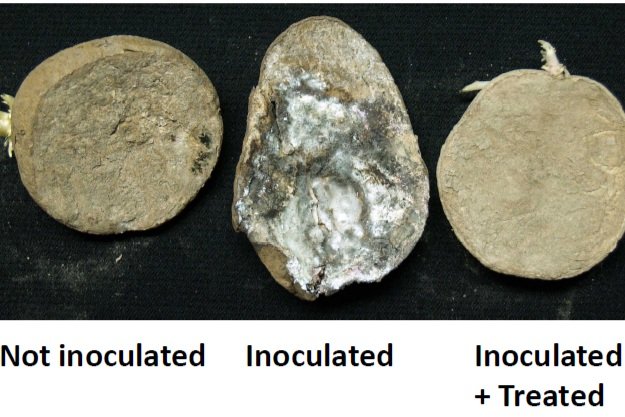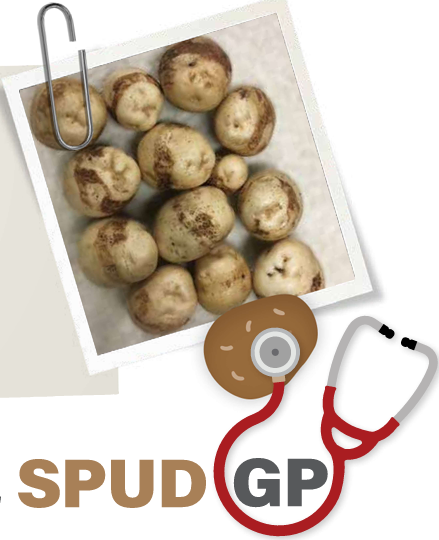PotatoLink Bulletin October 2022
The Australian Potato Growers Manual, PotatoLink magazine spring edition, Pink Rot webinar, and much more.
Smart farming using simple tech
In Issue 06 of PotatoLink magazine, Ryan Hall looks at the accessibility and mobility of technology available to growers in the form of drones, remote sensing and smartphone apps.
Potato bruising and management
Bruises develop due to impacts that either break the cells apart (shatter bruise) or rupture the cell membranes (blackspot). The risk of bruises can be reduced. This factsheet covers factors influencing potato bruising and how to manage them.
Technology test drive - CROP.ZONE Integrated weed management
In Issue 02 of PotatoLink magazine, you can read the article on the CROP.ZONE Integrated weed management system used as an alternative to herbicides to terminate potato crops.
Tomato potato pysllid (TPP) and zebra chip
This webinar on tomato potato psyllid (TPP) and zebra chip was delivered by Dr Melinda Moir, senior laboratory scientist in entomology at the Department of Primary Industries and Regional Development (DPIRD), and John Jackson, director of Potatoes New Zealand.
PotatoLink Bulletin September 2022
Potato permits available to growers, La Niña alert, new resources, and much more.
Pink Rot, Pythium, Dry Rot, and Soft Rot
Dr Phillip Wharton from Idaho University delivered this webinar on rot diseases in potatoes including Pink Rot, Leak (Pythium), Dry Rot and Soft Rot. It looked at the biology of the pathogens, symptoms and management options.
PotatoLink Bulletin August 2022
PotatoLink magazine winter edition, upcoming events, demonstration site news, and much more.
Late Blight (Phytophthora infestans)
Late Blight, also known as Irish Blight is caused by the fungal-like organism Phytophthora infestans, which can exist as two mating types, A1 and A2, each with numerous strains that have developed over time. Learn more about the disease, conditions conducive to its spread and management options.
Late Blight (Phytophthora infestans)
Join the PotatoLink team and guest speakers, Steven Johnson, Crop Specialist and Extension Professor from the University of Maine USA, and Rudolf de Boer, Senior Research Scientist at Agriculture Victoria, for the next webinar in the disease series - Late blight (Phytophthora infestans).
Pathogens - it’s all in their DNA
Developed by SARDI (South Australian Research and Development Institute), PREDICTA Pt is a commercial DNA testing service that can identify which pathogens are in the soil or skin of seed tubers.
In Issue 05 of PotatoLink magazine, Ryan Hall and Jenny Ekman from the PotatoLink team report on PREDICTA Pt including a 5-year case study describing its use in monitoring powdery scab and rhizoctonia on a commercial farm.
Using biologicals to sustainably maximise yield and increase returns
The rising costs of labour, fuel, power and fertiliser, coupled with a desire to embrace more sustainable practices, are driving the uptake of new biological and biostimulant products among potato farmers. Read more about biologicals in this PotatoLink magazine article.
Potassium, specific gravity and getting the balance right
Potato plants take up large quantities of potassium with peak daily uptake reaching over 4 kg/ha/day. Supplying potassium is most important during stolon and tuber initiation, although maximum uptake occurs during tuber bulking. This PotatoLink magazine article includes information on supplying potassium to crops and how potassium has helped Canowindra, NSW potatoes.
Question: Why are some of my spuds looking pretty ugly?
In Issue 05 of PotatoLink magazine, the Spud GP answers the question: Why are some of my spuds looking pretty ugly? As well as a comprehensive response, preventative strategies for the future are also offered.
PotatoLink Bulletin July 2022
World Potato Congress (WPC), upcoming events and webinars, new resources, and much more.




















